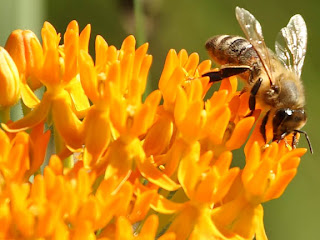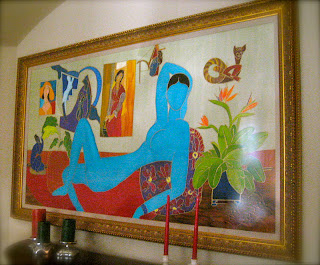Bees are invertebrates, which far outnumber us vertebrates by--well, here are the numbers: there are 35,000 known species of vertebrates and over 30 million species of invertebrates! You do the math. Moreover, scientists think that what we have identified so far is significantly less than what is actually out there. This will blow you away: "The number of individual insects estimated to be alive in the world at any one time is 10 quintillion" (for non-math majors: that's 10 with 18 zeros behind it). "It is figured that for every human being on the planet there are about 200 million insects." Ew. Creepy. Crawly. Buzz.
But now that I am slightly more enlightened about bees, (I'm into my fourth book, one documentary film, and several jars of honey, so I'm practically an expert) I'm not so creeped out. I'm actually a little in awe. Venturing out into bee territory came as a result of a conversation with a friend who gardens, and who decided to keep bees in order to pollinate her garden. . . and, I imagine, just for the challenge and fun of it. Just putting on the costume and firing up the smoker sounds so exotic, like something out of Africa!
It seems to me that bees pretty much 'keep' themselves--they have their own rhythm, organization, hierarchy, and instincts. But as much as you can 'keep' a wild animal, beekeepers do. Humans and bees have developed a symbiotic relationship, one that benefits both species. Besides producing honey, bees cross-pollinate about 90% of our wild plants and about a third of the world's food supplies, including many fruits, nuts, and vegetables. But, alarmingly, millions of bees have been vanishing in the past few years, and no one knows exactly why.
I hesitate to even go further because very quickly my lack of knowledge will begin to show. With each turn of the page, I realized how much more there was to learn about these gentle, hard-working creatures and how much we really do not understand. And, in fact, I'm not alone in this.
The honeybee may be the most widely-studied insect (of the 10 quintillion) on the planet, and yet scientists are still baffled as to their organization, intelligence, and social hierarchy. Who makes the decisions as to when they will swarm, when and how they decide to raise a new queen, when to dance? (yes--'waggle dance', to be more precise. It sounds like a Muppet movie).
Some have even conjectured that deep down in the dark, unreachable recesses of the hive, there is a mystical 'spirit of the hive' that joins the mind, body, and spirit of each colony of bees. Unless we are somehow able to get inside the mind of a bee, this will forever remain a mystery.
When I think of trying to understand the mind of God, let alone the mind of a bee, I feel overwhelmed and humbled. But instead of scaring us to death with His superior intelligence and awesomeness, God allowed us to get inside His head and heart by sending us Someone who spoke our language, lived in our 'hive', and even allowed us to become a member of His 'colony'.
What might have remained a complete and unattainable mystery has been split wide open, and the sweetest thing imaginable is revealed: The Creator loves His creation. Not only does He know exactly how many insects are crawling on the planet, He knows how many stars He has flung across the sky, and how many hairs He has put on my head. Not only does He know the mystery of the 'spirit of the hive', He knows all about me, right down to the deep, dark recesses of my soul.
Sweet.
I feel like firing up the smoker . . .and doing a waggle dance! God rules!
“I will give you the treasures of darkness and hidden wealth of secret places, so that you may know that it is I, The LORD, the God of Israel, who calls you by your name." Isaiah 45:3
"They are more desirable than gold, yes, than much fine gold; Sweeter also than honey and the drippings of the honeycomb." Psalm 19:10











